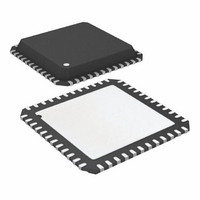ATA6613P-PLQW Atmel, ATA6613P-PLQW Datasheet - Page 53

ATA6613P-PLQW
Manufacturer Part Number
ATA6613P-PLQW
Description
MCU W/LIN TXRX REG WTCHDG 48-QFN
Manufacturer
Atmel
Series
AVR® ATA66 LIN-SBCr
Datasheet
1.ATA6612-EK.pdf
(364 pages)
Specifications of ATA6613P-PLQW
Core Processor
AVR
Core Size
8-Bit
Speed
16MHz
Connectivity
I²C, LIN, SPI, UART/USART
Peripherals
Brown-out Detect/Reset, POR, PWM, WDT
Number Of I /o
23
Program Memory Size
16KB (16K x 8)
Program Memory Type
FLASH
Eeprom Size
512 x 8
Ram Size
1K x 8
Voltage - Supply (vcc/vdd)
2.7 V ~ 5.5 V
Data Converters
A/D 8x10b
Oscillator Type
Internal
Operating Temperature
-40°C ~ 125°C
Package / Case
48-QFN Exposed Pad
Processor Series
ATA6x
Core
AVR8
Data Bus Width
8 bit
Data Ram Size
1 KB
Interface Type
I2C, SPI, USART
Maximum Clock Frequency
16 MHz
Number Of Programmable I/os
23
Number Of Timers
3
Maximum Operating Temperature
+ 125 C
Mounting Style
SMD/SMT
Minimum Operating Temperature
- 40 C
On-chip Adc
10 bit, 8 Channel
Lead Free Status / RoHS Status
Lead free / RoHS Compliant
Available stocks
Company
Part Number
Manufacturer
Quantity
Price
Company:
Part Number:
ATA6613P-PLQW
Manufacturer:
ATMEL
Quantity:
5 000
Part Number:
ATA6613P-PLQW
Manufacturer:
ATMEL/爱特梅尔
Quantity:
20 000
- Current page: 53 of 364
- Download datasheet (7Mb)
6.6.3
9111H–AUTO–01/11
Low Power Crystal Oscillator
Table 6-5.
Main purpose of the delay is to keep the AVR
The delay will not monitor the actual voltage and it will be required to select a delay longer
than the V
should be used. A BOD circuit will ensure sufficient V
time-out delay can be disabled. Disabling the time-out delay without utilizing a Brown-Out
Detection circuit is not recommended.
The oscillator is required to oscillate for a minimum number of cycles before the clock is con-
sidered stable. An internal ripple counter monitors the oscillator output clock, and keeps the
internal reset active for a given number of clock cycles. The reset is then released and the
device will start to execute. The recommended oscillator start-up time is dependent on the
clock type, and varies from 6 cycles for an externally applied clock to 32K cycles for a low fre-
quency crystal.
The start-up sequence for the clock includes both the time-out delay and the start-up time
when the device starts up from reset. When starting up from Power-save or Power-down
mode, V
Pins XTAL1 and XTAL2 are input and output, respectively, of an inverting amplifier which can
be configured for use as an On-chip Oscillator, as shown in
or a ceramic resonator may be used.
This Crystal Oscillator is a low power oscillator, with reduced voltage swing on the XTAL2 out-
put. It gives the lowest power consumption, but is not capable of driving other clock inputs, and
may be more susceptible to noise in noisy environments. In these cases, refer to the
Swing Crystal Oscillator” on page
C1 and C2 should always be equal for both crystals and resonators. The optimal value of the
capacitors depends on the crystal or resonator in use, the amount of stray capacitance, and
the electromagnetic noise of the environment. Some initial guidelines for choosing capacitors
for use with crystals are given in
values given by the manufacturer should be used.
Figure 6-12. Crystal Oscillator Connections
The Low Power Oscillator can operate in three different modes, each optimized for a specific
frequency range. The operating mode is selected by the fuses CKSEL3..1 as shown in
6-6 on page
Typ Time-out (V
CC
CC
is assumed to be at a sufficient level and only the start-up time is included.
54.
rise time. If this is not possible, an internal or external Brown-Out Detection circuit
4.1ms
65ms
0ms
Number of Watchdog Oscillator Cycles
CC
= 5.0V)
Table 6-6 on page
55.
Typ Time-out (V
C2
C1
Atmel ATA6612/ATA6613
®
4.3ms
69ms
0ms
in reset until it is supplied with minimum V
CC
54. For ceramic resonators, the capacitor
CC
XTAL2
XTAL1
GND
= 3.0V)
before it releases the reset, and the
Figure
6-12. Either a quartz crystal
Number of Cycles
4K (4,096)
8K (8,192)
0
Table
“Full
CC
53
.
Related parts for ATA6613P-PLQW
Image
Part Number
Description
Manufacturer
Datasheet
Request
R

Part Number:
Description:
MCU W/LIN TXRX REG WTCHDG 48-QFN
Manufacturer:
Atmel
Datasheet:

Part Number:
Description:
Ata6613
Manufacturer:
ATMEL Corporation
Datasheet:

Part Number:
Description:
BOARD DEMO LIN-MCM FOR ATA6613
Manufacturer:
Atmel
Datasheet:

Part Number:
Description:
DEV KIT FOR AVR/AVR32
Manufacturer:
Atmel
Datasheet:

Part Number:
Description:
INTERVAL AND WIPE/WASH WIPER CONTROL IC WITH DELAY
Manufacturer:
ATMEL Corporation
Datasheet:

Part Number:
Description:
Low-Voltage Voice-Switched IC for Hands-Free Operation
Manufacturer:
ATMEL Corporation
Datasheet:

Part Number:
Description:
MONOLITHIC INTEGRATED FEATUREPHONE CIRCUIT
Manufacturer:
ATMEL Corporation
Datasheet:

Part Number:
Description:
AM-FM Receiver IC U4255BM-M
Manufacturer:
ATMEL Corporation
Datasheet:

Part Number:
Description:
Monolithic Integrated Feature Phone Circuit
Manufacturer:
ATMEL Corporation
Datasheet:

Part Number:
Description:
Multistandard Video-IF and Quasi Parallel Sound Processing
Manufacturer:
ATMEL Corporation
Datasheet:

Part Number:
Description:
High-performance EE PLD
Manufacturer:
ATMEL Corporation
Datasheet:

Part Number:
Description:
8-bit Flash Microcontroller
Manufacturer:
ATMEL Corporation
Datasheet:











